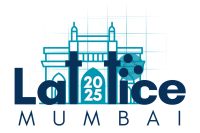Speaker
Description
Cuprate superconductors, the most commonly known class of high-$T_c$ superconductors, have much richer properties than the conventional superconductors, yet much of it is not well-understood. To explain their physical origin, many theories involving emergent gauge fields have been put forth in recent years. Focusing on the theory developed in Christos et al., PNAS 120(21) e2302701120 (2023), consisting of fundamental SU(2) bosons of charge $e$ coupled to emergent SU(2) gauge fields, we develop a Monte-Carlo algorithm to efficiently sample the fluctuating gauge and boson fields in presence of finite temperature. We demonstrate a Kosterlitz-Thouless transition from the superconducting (SC) to a pseudo-gap (PG) phase and the existence of vortices with flux $h/(2e)$ confirming that indeed these arise due to confinement of the SU(2) gauge fields. Furthermore, we explicitly show the existence of a period-4 charge order nucleating inside the vortex cores, observed in the experiments by Hoffman et al., Science 295, 466 (2002). Further, we also observe Fermi arcs in the electronic spectral density in the high temperature PG phase where quantum oscillations of hole pockets with fractional area in the local electron density of states are also observed, thus unifying these seemingly unrelated phenomena within the framework of a single theory.
| Parallel Session (for talks only) | Theoretical developments and applications beyond Standard Model |
|---|

